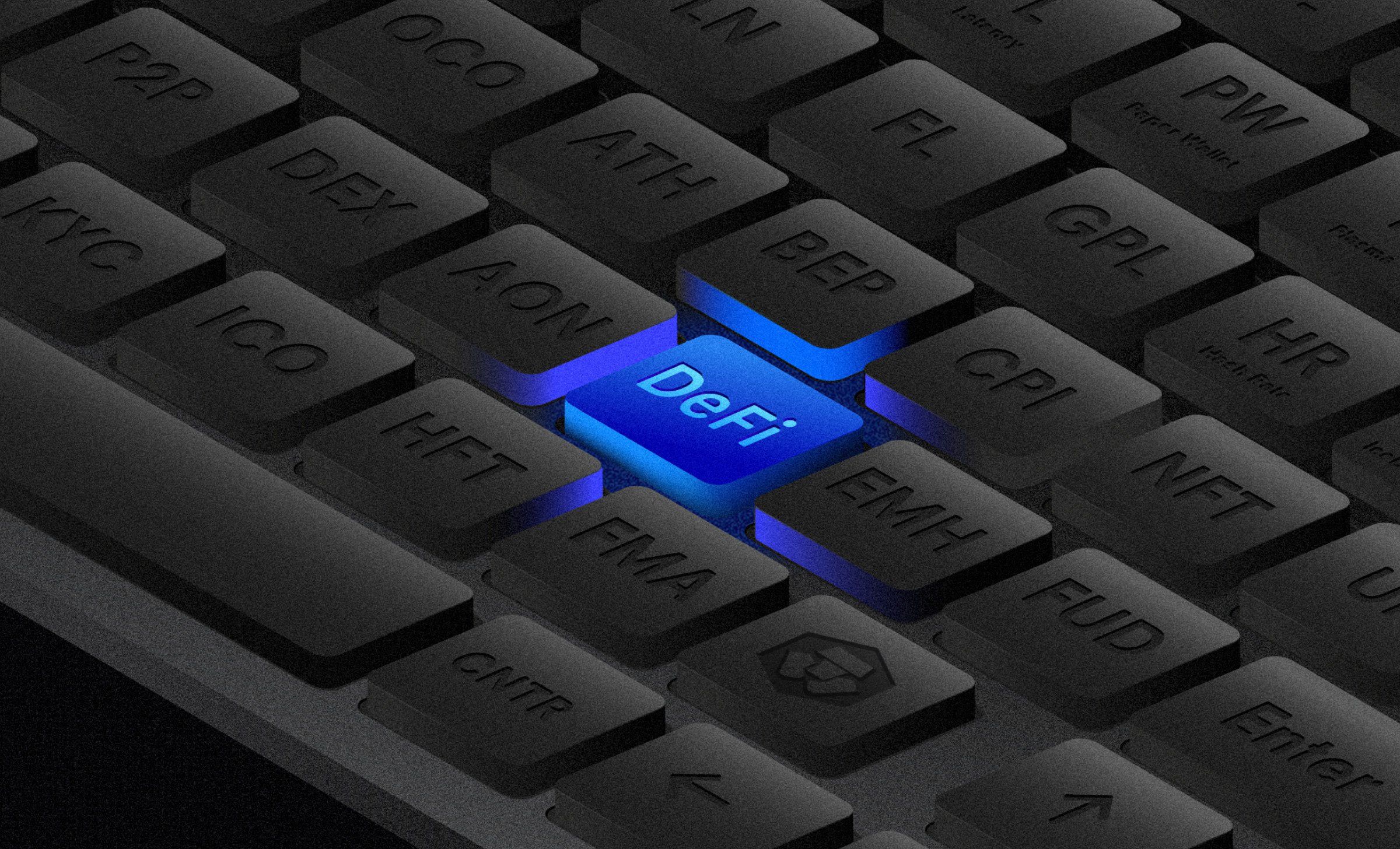- Key Takeaways:
- What Is DeFi?
- Decentralised Apps (Dapps)
- What Is a Decentralised Exchange (DEX)?
- Popular Dapps and DEXs
- Final Words on DeFi

What Is DeFi?
An introduction to the basics of decentralised finance (DeFi) and three projects suitable for beginners.

Cryptocurrency has evolved into much more than just a new version of digital cash or payments. It is a new financial ecosystem built using blockchain’s globally accessible, censorship-resistant, non-haltable, and autonomous platform.
Here we introduce the basics of decentralised finance (DeFi) and how users can unlock the full potential of their crypto.
Key Takeaways:
- Short for decentralised finance, DeFi is an umbrella term for financial applications that do not have any central point of authority.
- Decentralised applications (dapps) are a type of application that typically runs on a decentralised network; they are usually open-source software powered by smart contracts.
- A decentralised exchange (DEX) is a peer-to-peer (P2P) marketplace where users can trade digital assets without the need for an intermediary.
What Is DeFi?
DeFi is an abbreviation of ‘decentralised finance’, which is software built on top of a blockchain that enables the creation of services much like standard centralised financial services — with the added benefit of decentralisation. This means that users interact with smart contracts and code rather than a central authority, such as a bank.
To illustrate, picture an individual who intends to lend their excess capital, and another who intends to borrow money for their business. Traditionally, they would have to go through a centralised financial institution, such as a bank. On top of that, the bank also has the power to decide whether the individuals are eligible for the services.
DeFi, however, eliminates the entire discussion process, as both the lender and borrower need only to interact with a smart contract, in which the terms and conditions of the transaction will have already been predefined. This transforms a rather demanding procedure into a decentralised one that is fair to all users.
Decentralised Apps (Dapps)
Decentralised apps (dapps) are autonomous and the backbone of DeFi. These protocols allow users to unlock the potential of DeFi by letting the smart contracts do the work, instead of a traditional central financial institution.
The challenge of a robust DeFi ecosystem is that it must incentivise the security of the platform, as well as its usage. To further understand a DeFi ecosystem, it’s important to understand dapps and how they play a major role in it.
You may also be interested in How to Use DeFi — A Beginner’s Guide.
How Do Dapps Work?
Dapps usually — but not necessarily — run on a blockchain, and their interfaces should look no different from any website or mobile app we use today. Dapps are able to provide the same support as a typical app, with the added benefit of enjoying all the advantages of decentralisation.
Dapps may run on top of existing public blockchains — for instance, Cronos or Ethereum, and any changes in data or information on a blockchain involve the participation of all nodes. Not a single entity has the authority to delete or modify the status or the information once it’s posted on the network. This transparency allows dapps, which are censorship-resistant and autonomous, the advantage of having no single point of failure.
Dapps typically have the following characteristics:
- A public and decentralised blockchain (or P2P network) where data and information are kept
- Cryptocurrencies
- Open-source software
- Community voting system where any changes are typically decided through a government system or a decentralised autonomous organisation (DAO)
- No central point of failure; cannot be shut down due to the absence of a centralised server
What Is a Decentralised Exchange (DEX)?
One of the most common dapps is a decentralised exchange (DEX), which is a vital part of any DeFi ecosystem. It facilitates the core function within DeFi: the ability to exchange tokens. DEXs offer users a more decentralised service than a standard centralised exchange (CEX) because they are Automated Market Makers (AMM), which use liquidity pools to allow for trades.
In traditional order books, the CEX connects buyers and sellers to perform transactions, and users only have access to the tokens it provides. Whereas, on a decentralised exchange, users have access to virtually any token, since any user is able to provide liquidity.
To access dozens of DEXs in one app, download the Crypto.com DeFi Wallet.
Popular Dapps and DEXs
Below are some of the most popular dapps found on the Cronos blockchain. All can be accessed easily through the Crypto.com DeFi Wallet.
MM Finance
Overview
Platform: Cronos
Token: $MMF
Category: Automated Market Maker decentralised exchange
How Does MM Finance Work?
MM Finance (MMF), short for Mad Meerkat Finance, is one of the leading DEXs on the Cronos blockchain. It does not have a centralised service provider or an order-book matching mechanism. Instead, MM Finance automates transactions between cryptocurrency tokens on the Cronos blockchain through the use of smart contracts. It pools liquidity from liquidity providers (LPs) who supply the system with tokens for a proportional share of transaction fees. The AMM portion of MM Finance allows for liquidity to be provided to the exchange, and it operates through automated trading methods.
MM Finance handles a large volume of trades on the Cronos blockchain, and users can find different yield farming opportunities from over 20 different farms. Since MM Finance does not have an order book, it relies on pooled liquidity. Users can provide liquidity to earn rewards in the form of fees generated by charging users 0.17% per swap.
VVS Finance
Overview
Platform: Cronos
Token: $VVS
Category: Automated Market Maker decentralised exchange
How Does VVS Finance Work?
VVS Finance, which stands for ‘very, very simple’ finance, is a dapp on Cronos designed to bring various types of protocols to the masses. This platform is built on the vision to provide a gateway into the DeFi space through an easy-to-use interface. Users on the platform can swap tokens and earn high yields while paying cheap transaction fees with minimal slippage.
VVS Finance, like MM Finance, is a DEX. It has fine-tuned its tokenomics using an Automated Market Maker (AMM) to determine the price of specific digital assets. With this, the protocol incentivises all parties within the ecosystem to ensure long-term growth and the sustainability of the platform.
According to the lite paper, VVS has six key features:
- Bling Swap: An algorithmic system that allows users to swap specific tokens across a variety of liquidity pools for a better price.
- Liquidity Provision: Allows users to become a liquidity provider (LP) by depositing tokens into a liquidity pool in exchange for a CRC-20 LP token as proof of proportional ownership.
- Crystal Farm: LPs can stake their LP tokens in the ‘Crystal Farm’ to receive VVS tokens.
- Glitter Mine: Non-LP users can stake their VVS tokens to receive VVS or partner tokens in rewards.
- Initial Gem Offering: Allows LP token and VVS token holders early access to new project tokens in the Cronos blockchain ecosystem.
- Analytics: Users have access to the analytics and data of the VVS Finance protocol.
Tectonic
Overview
Platform: Cronos
Token: TONIC
Category: Decentralised money market
How Does Tectonic Work?
Tectonic is a DeFi protocol that aims to provide cross-chain money market services. This protocol, which is built on the Cronos blockchain, intends to simplify the process of lending and borrowing for both market participants and users.
The Tectonic algorithm relies on over-collateralisation to protect its lending platform. More precisely, the platform has a collateral factor to determine the amount of money borrowers must lock in. Each cryptocurrency has a different collateral factor, which represents how much a user can borrow. For instance, if wETH has a collateral factor of 75%, it means the user can borrow $750 worth of cryptocurrency for every $1,000 locked in. However, the collateral factor for each asset is subject to change.
MMF, VVS, Tectonic, and other dapps can all be accessed through the Crypto.com DeFi Wallet.
Final Words on DeFi
In this short intro to DeFi, dapps, and DEXs, we introduced the new financial system that allows people to trade peer-to-peer, without the involvement of a middleman. DeFi is truly revolutionary and offers huge potential, especially for the roughly one-third of the world’s population that remains unbanked and excluded from the traditional financial (TradFi) system.
Due Diligence and Do Your Own Research
All examples listed in this article are for informational purposes only. You should not construe any such information or other material as legal, tax, investment, financial, or other advice. Nothing contained herein shall constitute a solicitation, recommendation, endorsement, or offer by Crypto.com to invest, buy, or sell any crypto assets. Returns on the buying and selling of crypto assets may be subject to tax, including capital gains tax, in your jurisdiction. Any descriptions of Crypto.com products or features are merely for illustrative purposes and do not constitute an endorsement, invitation, or solicitation.
Past performance is not a guarantee or predictor of future performance. The value of crypto assets can increase or decrease, and you could lose all or a substantial amount of your purchase price. When assessing a crypto asset, it’s essential for you to do your research and due diligence to make the best possible judgement, as any purchases shall be your sole responsibility.
Share with Friends
Ready to start your crypto journey?
Get your step-by-step guide to setting upan account with Crypto.com
By clicking the Submit button you acknowledge having read the Privacy Notice of Crypto.com where we explain how we use and protect your personal data.





